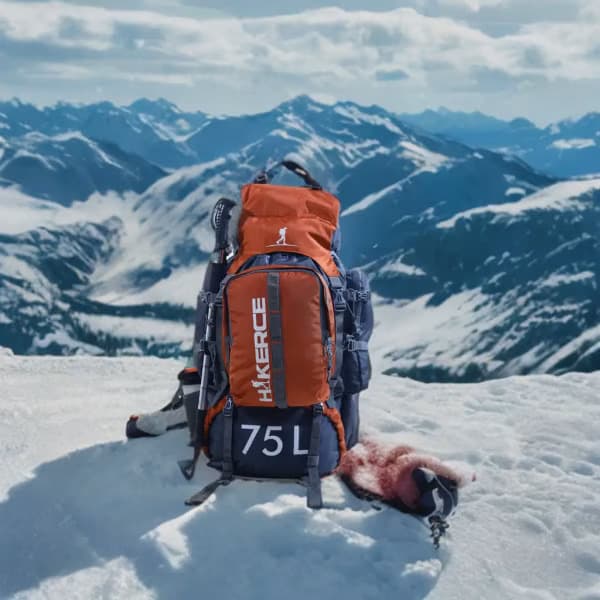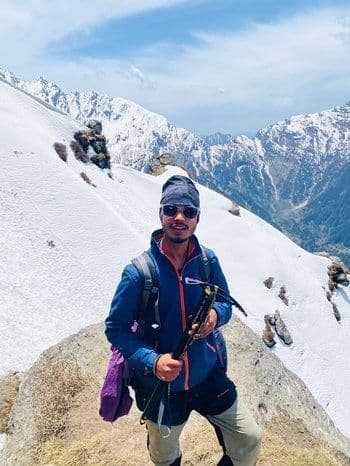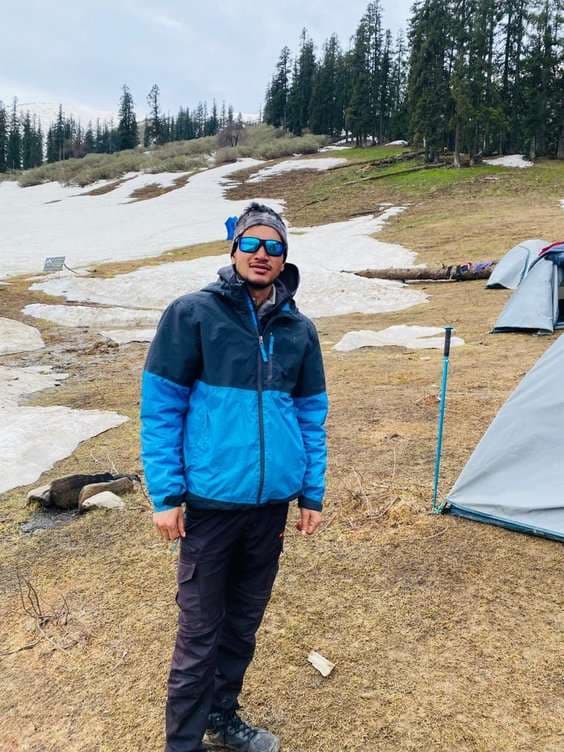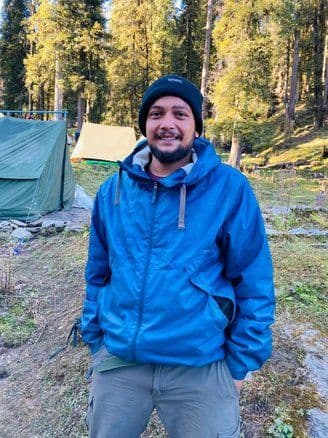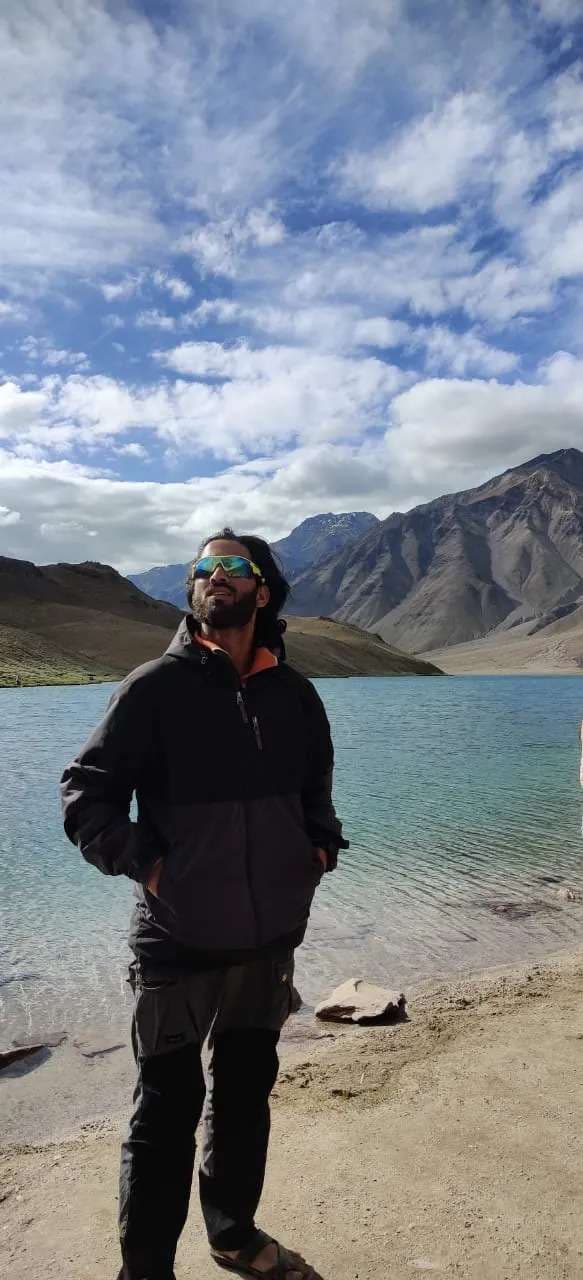Kedar Dome, also known as Kedarnath Dome, is a prominent peak located in the Garhwal Himalayas of Uttarakhand, India. Kedar Dome is situated in the Gangotri Group of peaks in the Garhwal region of Uttarakhand. The peak has an elevation of approximately 6,808 meters (22,339 feet) above sea level, making it one of the challenging peaks in the region. Kedar Dome is surrounded by other notable peaks, including Thalay Sagar, Bhagirathi II, Bhagirathi III, and the legendary Shivling peak.
The region around Kedar Dome is characterized by several glaciers, including the Gangotri Glacier, which is one of the largest glaciers in the Himalayas. The Gangotri River, originating from the Gangotri Glacier, flows through the region, eventually becoming the sacred River Ganges.
The region around Kedar Dome holds religious significance for Hindus due to its proximity to the Kedarnath Temple, one of the Char Dham shrines in Hinduism. Pilgrims visit Kedarnath Temple as part of the Char Dham Yatra. Kedar Dome has a history of mountaineering expeditions, with climbers attempting its summit to test their technical skills and endurance. Its proximity to the Kedarnath Temple area adds to its allure. The first recorded ascent of Kedar Dome is attributed to a British team led by R. D. Graham in 1947. Since then, it has been climbed by various mountaineers, contributing to the exploration of the Garhwal Himalayas. Like many other peaks in the region, Kedar Dome and its surroundings are subject to environmental conservation efforts to preserve the fragile alpine ecosystems and glacial landscapes.
Kedar Dome's combination of mountaineering challenges, religious significance, and stunning Himalayan landscapes make it an intriguing destination for both climbers and those interested in exploring the cultural and natural heritage of the Garhwal region. It is a part of the rich tapestry of the Indian Himalayas, drawing adventurers and pilgrims alike to its vicinity.
Best Time For Kedar Dome Expedition
The best time for a Kedar Dome expedition, which involves mountaineering in the Garhwal Himalayas, is typically during the late spring and early summer months. This corresponds to the pre-monsoon season in the region. Here's more information about the best time to attempt a Kedar Dome expedition:
Late Spring to Early Summer (May to June):
Late May to early June is considered the primary climbing season for peaks in the Garhwal Himalayas, including Kedar Dome.
During this period, the weather is relatively stable, and the snow and ice conditions on the mountain are favorable for mountaineering.
The temperatures are milder compared to the winter months, making it more comfortable for climbing.
The days are longer, providing ample daylight for the ascent and descent.
This time offers clear views of the surrounding peaks, creating a picturesque environment.
Key Considerations:
Monsoon Season (July to August): It's crucial to avoid the monsoon season in the Indian Himalayas, which typically occurs from July to August. This season brings heavy rainfall, landslides, and unstable conditions in the region, making it unsafe for mountaineering.
Post-Monsoon Season (September to October): After the monsoon season, from September to October, is another suitable period for mountaineering expeditions in the region. The weather stabilizes, and the landscape becomes lush and green. However, the snow and ice conditions may not be as favorable as in late spring.
When planning a Kedar Dome expedition, it's essential to consider factors like weather, personal fitness, technical skills required for mountaineering, and safety precautions. Ensure that you are well-prepared, have the necessary permits, and are aware of the challenges associated with high-altitude climbing in the Garhwal Himalayas. Hiring experienced guides and support staff is highly recommended to enhance safety and success on the expedition.
Things To Carry For Kedar Dome Expedition
A Kedar Dome expedition is a challenging highaltitude mountaineering endeavor, and it's essential to carry the right gear and equipment to ensure your safety and comfort. Here is a comprehensive list of items to carry for a Kedar Dome expedition:
1. Clothing:
Insulated down jacket
Waterproof and windproof shell jacket and pants
Insulated pants or bibs
Synthetic or merino wool base layers (tops and bottoms)
Moisturewicking, quickdrying hiking shirts
Warm fleece or synthetic midlayer
Warm gloves and mittens (waterproof)
Warm hat and balaclava
Gaiters to keep snow out of your boots
Mountaineering boots with insulation and compatible with crampons
Warm, moisturewicking socks (multiple pairs)
Sunglasses with UV protection and side shields
Ski goggles for high-altitude glare and snow
Sunhat or baseball cap
Neck gaiter or buff
2. Mountaineering Equipment:
Crampons
Ice axe with leash
Climbing harness
Climbing helmet
Locking carabiners
Prusik cords
Sewn slings and runners
Climbing rope (length and diameter as required)
Snow pickets (for crevasse rescue)
Snow shovel and probe
3. Camping and Shelter:
Four-season, high-altitude tent with a rainfly
Sleeping bag suitable for cold temperatures (down or synthetic)
Sleeping pad (insulated)
Compression stuff sacks for gear organization
4. Technical Equipment:
GPS device and maps
Compass and altimeter
Personal locator beacon (PLB) or satellite communicator
Headlamp with extra batteries
Multitool or knife
Trekking poles for balance and support
5. Backpack and Packing:
Expedition sized backpack with padded hip belt and adjustable torso length
Daypack for summit attempts and short excursions
Dry bags or stuff sacks for organizing and waterproofing gear
Plastic bags for keeping gear dry in your backpack
6. Food and Hydration:
High-energy snacks (energy bars, nuts, dried fruits, etc.)
Freeze-dried or dehydrated meals for the expedition
Stove and fuel canisters
Cooking pot and utensils
Water purification system (iodine tablets, water filter, or UV purifier)
Hydration system (water bottles or hydration reservoir)
7. First Aid and Personal Care:
Comprehensive first aid kit
Prescription medications and personal medical supplies
Sunscreen with high SPF
Lip balm with sunscreen
Insect repellent
Hand sanitizer and wet wipes
Toilet paper and trowel (for waste disposal)
Personal toiletries
8. Climbing Accessories:
Climbing gloves for rope work
Ascenders and descenders (if needed)
Belay device and rappel device
Climbing slings and cord
Climbing tape and bandages for finger protection
9. Documentation:
Passport, visa, and permits (check and secure all necessary documentation)
Copy of emergency contact information and travel insurance details
10. Communication:
Satellite phone or twoway radio (if available)
11. Miscellaneous:
Repair kits for gear and clothing
Duct tape and zip ties
Multiday supply of personal prescriptions and essential medications
Extra camera batteries and memory cards (if carrying a camera)
Book, journal, or entertainment for downtime.
Remember that your gear should be suitable for highaltitude and coldweather conditions. Ensure that everything is in good working condition, and test your equipment before the expedition. Additionally, pack sensibly to keep your load manageable while also being prepared for unpredictable weather in the high mountains. It's highly recommended to consult with experienced mountaineers or guides for specific gear recommendations and tips for your Kedar Dome expedition.
How To Reach Dehradun
Dehradun, the capital of the Indian state of Uttarakhand, is a wellconnected city with various transportation options for travelers. Here's how to reach Dehradun by different modes of transportation:
By Air:
1. Jolly Grant Airport (Dehradun Airport): The nearest airport to Dehradun is the Jolly Grant Airport, which is located approximately 25 kilometers (16 miles) away from the city center. It is a domestic airport and operates flights from major Indian cities like Delhi, Mumbai, Bangalore, and more. Once you land at the airport, you can hire a taxi or take a prepaid taxi to reach Dehradun city.
By Train:
1. Dehradun Railway Station: Dehradun has its railway station, which is wellconnected to major cities in India. Several trains run to and from Dehradun, making it an accessible destination by train. You can check the train schedule and book tickets in advance through the Indian Railways website or at the railway station.
By Road:
1. By Bus: Dehradun is wellconnected by road, and you can reach the city by staterun buses, private buses, or taxis. The city's bus stand, ISBT Dehradun, serves as a major bus terminal and operates buses from various parts of North India. You can choose from regular buses, semisleeper, and sleeper buses based on your preferences and budget.
2. By Car: If you prefer a more flexible and private mode of transportation, you can drive to Dehradun. The city is connected by road to major cities like Delhi, Chandigarh, and Haridwar. The road network is generally good, and you can use Google Maps or other navigation apps to plan your route.
By Train and Bus Combo:
You can also opt for a combination of train and bus travel to reach Dehradun. After reaching the Dehradun Railway Station, you can easily find local buses, autorickshaws, or taxis to take you to your destination within the city.
Before you travel, it's a good idea to check the latest travel advisories, transportation schedules, and any COVID19related guidelines or restrictions that may be in place. This will help ensure a smooth and hasslefree journey to Dehradun.
How To Prepare For Kedar Dome Expedition
Preparing for a Kedar Dome expedition, which involves mountaineering in the Garhwal Himalayas, is a challenging endeavor that requires physical fitness, technical skills, and proper planning. Here's a comprehensive guide on how to prepare for a successful Kedar Dome expedition:
1. Physical Fitness:
Cardiovascular Endurance : Build your cardiovascular fitness through activities like running, hiking, cycling, and swimming. Aim for aerobic exercises that elevate your heart rate.
Strength Training : Strengthen your legs, core, and upper body to handle the physical demands of mountaineering. Focus on exercises like squats, lunges, planks, and upper body workouts.
Endurance Training : Gradually increase the duration of your outdoor hikes and treks to build endurance and stamina.
Altitude Training : If possible, incorporate altitude training or hikes at high altitudes to help your body acclimatize.
2. Technical Skills:
Mountaineering Skills : Develop essential mountaineering skills, including rope work, ice and rock climbing techniques, crevasse rescue, and glacier travel.
Navigation : Familiarize yourself with map reading, using a compass, and GPS navigation.
Climbing Gear : Learn to use technical climbing equipment like ice axes, crampons, harnesses, helmets, ropes, and carabiners.
3. Acclimatization:
Plan an acclimatization schedule to gradually ascend to higher altitudes before attempting the climb. Spend time at different altitudes to adapt to reduced oxygen levels.
Recognize the symptoms of altitude sickness (AMS, HACE, HAPE) and know how to respond if symptoms arise.
4. Gear and Equipment:
Prepare a comprehensive gear checklist, including clothing, camping gear, mountaineering equipment, and personal items.
Ensure that your gear is suitable for highaltitude mountaineering and is in excellent condition.
Invest in quality insulated clothing, waterproof and windproof layers, mountaineering boots, and other specialized gear.
5. Physical Health:
Undergo a thorough medical checkup to ensure you are physically fit for highaltitude mountaineering.
Consult with a doctor about vaccinations and medications required for the region.
Carry a comprehensive first aid kit and know how to use it.
6. Mental Preparation:
Develop mental toughness to handle the physical and mental challenges of highaltitude mountaineering.
Cultivate a positive attitude and mental resilience to cope with adversity.
7. Expedition Logistics:
Obtain the necessary permits and documentation for the expedition.
Arrange for experienced local guides, porters, and support staff who are familiar with the region.
Plan transportation, accommodations, and food supplies for the expedition.
8. Safety Protocols:
Familiarize yourself with safety protocols, including communication plans, emergency evacuation procedures, and helicopter rescue services in the region.
Ensure you have adequate insurance coverage for highaltitude mountaineering.
9. Environmental Responsibility:
Follow Leave No Trace principles to minimize your impact on the environment. Pack out all waste and trash.
10. Training Treks:
Participate in training treks or hikes in similar terrain and altitude to gain experience and assess your physical condition.
Attend mountaineering or trekking workshops to practice essential skills and techniques.
Safety Factors For Kedar Dome Expedition
Safety is paramount when embarking on a challenging expedition like Kedar Dome in the Garhwal Himalayas. Here are important safety factors and precautions to consider for a safe and successful Kedar Dome expedition:
1. Experienced Guides and Support Team:
Hire experienced local guides who are familiar with the region, its terrain, and the challenges of Kedar Dome.
Ensure that your support team, including porters, cooks, and assistants, is welltrained and equipped for the expedition.
2. Physical Fitness and Acclimatization:
Ensure that all team members are physically fit and have undergone proper acclimatization training before attempting the expedition.
Plan a gradual ascent to allow for adequate acclimatization, which reduces the risk of altitude sickness.
3. Weather Monitoring:
Stay updated on weather forecasts for the region. Be prepared for sudden weather changes, especially in highaltitude areas.
Avoid trekking or climbing in adverse weather conditions, and be ready to alter your plans if necessary.
4. Altitude Sickness Awareness:
Train expedition members to recognize the symptoms of altitude sickness, including Acute Mountain Sickness (AMS), High Altitude Cerebral Edema (HACE), and High Altitude Pulmonary Edema (HAPE).
Carry necessary medications like Diamox and know how to administer them if symptoms occur. Descend to lower altitudes if symptoms worsen.
5. Proper Equipment and Gear:
Ensure that all expedition members have the appropriate gear, clothing, and equipment for high altitude mountaineering.
Regularly check gear to ensure it is in good condition and properly functioning.
6. Emergency Communication:
Carry communication devices like satellite phones or personal locator beacons (PLBs) for emergencies.
Establish a communication plan with your support team and notify them of your whereabouts.
7. First Aid and Medical Supplies:
Carry a comprehensive first aid kit and know how to use it.
Include medications for common mountain ailments and injuries.
8. Emergency Evacuation Plan:
Develop a well-defined emergency evacuation plan in case of severe illness or injury.
Be aware of helicopter rescue services available in the region and how to contact them.
9. Hydration and Nutrition:
Stay well-hydrated by drinking plenty of water. Dehydration can exacerbate altitude related problems.
Maintain a balanced diet to ensure sufficient energy and nutrition.
10. Climbing Safety:
If undertaking technical climbing, ensure proper use of safety equipment like ropes, harnesses, helmets, crampons, and ice axes.
Follow established mountaineering safety protocols and techniques.
11. Environmental Responsibility:
Adhere to Leave No Trace principles to minimize your impact on the environment. Pack out all waste and trash.
12. Team Communication and DecisionMaking:
Foster open communication within the team to discuss safety concerns and make informed decisions.
Encourage teamwork and cooperation among expedition members.
13. Route Knowledge and Navigation:
Familiarize yourself with the expedition route, terrain, and key landmarks.
Carry maps, GPS devices, and compasses for navigation.
14. Expedition Logistics:
Plan logistical details in advance, including transportation, accommodations, and food supplies.
Have a contingency plan for logistical challenges.
15. Risk Assessment:
Continually assess risks and make informed decisions based on changing conditions and team capabilities.
Be prepared to turn back or delay the expedition if safety concerns arise.
16. Emergency Protocols:
Establish clear emergency protocols, including how to communicate distress signals and coordinate rescues.
17. Local Knowledge and Customs:
Respect local customs and traditions. Seek guidance from locals if needed.
Safety is a collective responsibility, and each member of the expedition team should be vigilant and prepared to respond to potential risks and emergencies. Prioritize safety over summit objectives, and be ready to adapt plans to ensure the wellbeing of all team members.



